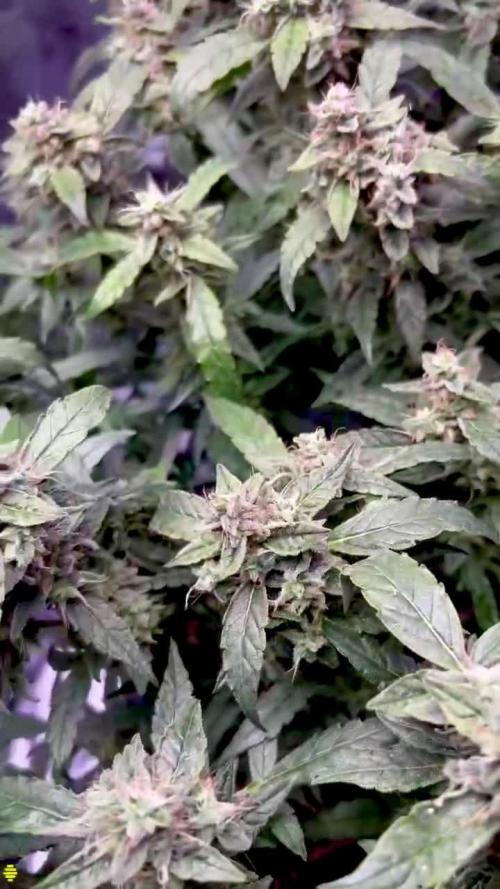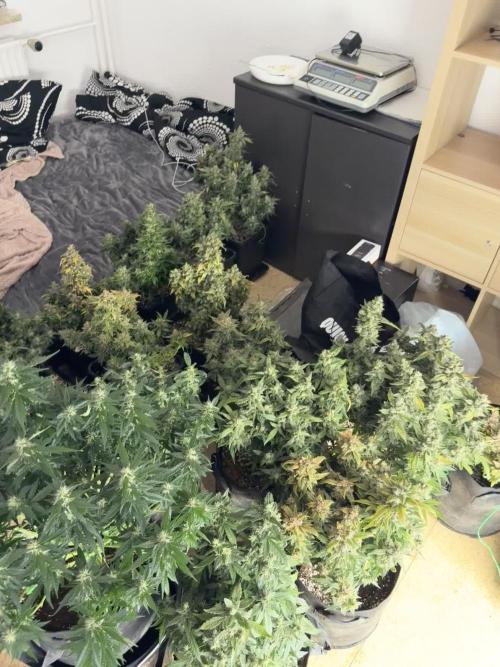The Grow Awards 2026 🏆 































Likes
Comments
Share


@hooolian
Follow
24/02: Colas again have become real heavy in places and have had to strap them together to prevent the stalks from falling and snapping. Over all blooming well have been on maximum dose of nutrients now for a few weeks. lots of orange hairs. water now for a week and then to harvest. the topping in this grow really paid off.
Likes
18
Share


@Rinna
Follow
As said before, I'm incredibly happy that I got to harvest a little bit. Never expected her to make it, but she kind off did! The smell was pungent and sweet like an amnesia haze should be, hoping that will be even better after drying and curing!
Likes
15
Share


@curious_jules
Follow
Edging along. Less leggy now. Would probably benefit from longer hours of light, but my Haze is in third week of flowering and 12/12 is mandatory just now. Haven't filled the DWC pot yet. Once a week I dip the rockwool in a weak Ionic Hydro Grow solution. That's all she gets, for now.
Likes
47
Share


@GrowGuy97
Follow
Day 49 - Have been having a bit of a high humidity problem in the tent but will be getting a new dehumidifier soon to keep that under control but over all these ladies are growing beautifully & seem to be very healthy! I am extremely impressed at how well they are doing with little to no nutrients, the buds are starting to get thicker & put on some frost! Make sure to check back for more updates, thanks for following & happy growing friends!🙏🏼✌️🏼🌱
Likes
31
Share


@Mr_ZAF_Budz
Follow
Hello Canna Fam,
So week 10 has come to an end and the ladies are doing well. I started to feed only PH’ed water yesterday and hopefully as EC levels drop the girls should go into overdrive and hopefully push to increase bud density before they get the chop.
I have been struggling some days with extremely low levels of humidity so the environment has not been perfect but nevertheless things aren’t looking too bad.
The late blooming Gorilla Glue will still be feed nutrients until she is ready for flush, roughy another 2-3 weeks.
I hope you all enjoy the progress and happy growing to you all.✌️🏼
Likes
39
Share


@BUZIMAN
Follow
I started rinsing 2 days ago, the trichromes are well formed and starting to turn milky. The end is near. 😎✌️🍀
Likes
8
Share


@CK-OrgGrow
Follow
Woche 7
Die Mimosa Fast von 00 Seeds Bank kommt langsam in die letzte Phase wo die Blüten einiges an Gewicht zulegen sollten. Soweit geht es den Mimosa auch weiter gut. Die Blüten bilden sich weiter aus, werden dicker und verharzter.
Erstaunlicher weise haben die Pflanzen vom geringen abstand der LED Lampe (EVO6-150) immer noch keine negativen Auswirkung oder Schäden.
Am Dünger habe ich in dieser Woche nix verändert. Ich denke nächste Woche werde ich den Dünger noch mal für ca. 2 Wochen anpassen.
Likes
44
Share


@Zorachus
Follow
Ok, all caught up. I haven't done an update in almost 6 weeks. I've been so busy. Lots of picture updates!
First of all, there have been flashlights in my back yard, so I am going to have to start bringing them inside for the night soon. It's been on the news that kids are taking pictures and staking out plants already. Not good.
The Lost Coast Plant Therapy is still working great for the powdery mildew. The fish fertilizer is slowing the yellowing leaves, but they are still turning yellow. I think i will be ok, I am not too worried.
I am about to do my last feeding of the year after writing this. I will be giving them a heavy Gaia Green Power Bloom dose, and some bat guano.
They are smelling and looking great, and I cant believe how fast the buds are growing. I'd say 4-5 weeks to go, tops, hopefully sooner.
Likes
9
Share


@TheGreenGroomer
Follow
🌿 Grow Diary Update: Week 5 Check-In 🌿
Hey growers,
Can you believe it's Week 5 already? Time's flying, and so is our girl – she's a beast now! I've been itching to defoliate more, but I've maxed out the amount of defol i can do and i have now stopped completely to avoid stressing her out too much :/
Overall, she's looking happy, but I noticed some leaves getting darker than I'd like, so I dialed down the nitrogen a bit...
Remember my PPMS struggle? Well, good news – got them down to 1200ppm but could not get it any lower.. i could lower the ppm/ec of intake even more to hopefully drop it but in this stage of flower feeding lower than 800ppms is too low unless you need to flush to reset the medium so i am just gonna keep sticking to the 800ppm feed for now and measure run off each time hopefully i can get it around 900-1000, yes these high ppm/ec levels are fine for cannabis but mostly when your using co2 thats like 700ppm+ but at the end of the day SHE LOOKS GREAT!
Here's to another week of growth and learning!
Happy growing,
TheGreenGroomer🌱
ps - sorry for over exposed/out of focus images i will get better images for next update, also smells allot stronger when humidity is on the higher end, she smells so good!
Likes
12
Share


@2Byte
Follow
Coming up on third base! No issues at all from the recent wetness and really getting some nice purps on the GG4xGSC and the Green Gelato. Ironically nothing yet on the Ayahuasca Purple.
Processing
Likes
22
Share


@DankBudz
Follow
Just got a remo kit.
Goin to start adding astroflower, kelp and remo bloom this week.
Dropped humidity to 45.
Likes
4
Share


@NiBaMeCa420
Follow
Hi fellow growers,
We are in the middle of the flowering fase 4th week passed going in the 5th week and i must say that this strain is giving no problems very easy grow, buds are developing very good and you can see how the canopy is filling up with delicious resinous buds it performs great and scrogging this hvy weight was the right choice the leaves are still pointing proudly upwards and you can see by the color of the leaves that the growing conditions are perfect are humidity is averaging at 48 percent could be a little lower bud in this stage of flowering i have no problem with the humidity beeing a little on the high side but that is something we have to get fix in the near future before we get to the point that mould could begin to form
Lighting is in about 40cm above the canopy delivering a good spread over the whole canopy and penetrates deep into the lower leaves for those little buds that are down there so they also will get nice and compact
That is all for today
Happy 4/20 everyone im going to roll a fatty
Stay green and above all stay safe
Cheers,
Nibameca
Likes
25
Share


@Lou_Grows
Follow
She recovered very well from last week training and lollipop. I hope this technique gives me good results, is looking promising so far, I decided to lower the nutrient amounts to half the recommended from advanced nutrients since I burnt my pineapple chunk a little.
Likes
22
Share


@julian100614
Follow
El ciclo fué perfectamente desde el principio. Bien es cierto que puse dos plantas y una fué la que tiró realmente bien. Se realizó una poda apical que respondió perfectamente creando dos grandes puntas y con un pequeño LST conseguimos ajustar el resto de ramas a la misma altura para que crecieran uniformemente y la luz les diera de igual manera a todas las puntas.
En general me ha gustado mucho cultivar la AK48 DE WEEDSEEDSEXPRESS en primer lugar por la novedad, en segundo por la facilidad de cultivo y por ultimo por los resultados tan maravillosos de esta genetica 👌👏
Repetiré sin duda 😊💪
BUENOS HUMOS 🔥
Likes
12
Share


@2Stones1Bird
Follow
Checkout my Instagram @smallbudz to see the Small budget grow setup for indoor use, low watt, low heat, low noise, step by step.
12/01/2020 - Fed her 1.5l of 6.6PH water with 0,2ml of each: Cal Mag (Atami), Grow, Bloom and Max, and 0,5ml of each: Heaven, Alga-mic and Vera, noticed some run off, I use about 1/4 of the nutrient dosage on the chart, to achieve about 100/150PPM (500 scale).
Now using the perfect PPM worsheet made by Grow Boss.
Likes
19
Share


@Little_E
Follow
It was my first grow so I know my next crack at this strain would be much better. I didn't have too many issues or any crazy setbacks. It was smooth sailing for a while and then had some nute/deficiency issues but it was later in flower. I did move them into a bigger tent with a far better light but not until the last 3 weeks of flower. So I know I'll have to grow this again in the future and compare!























